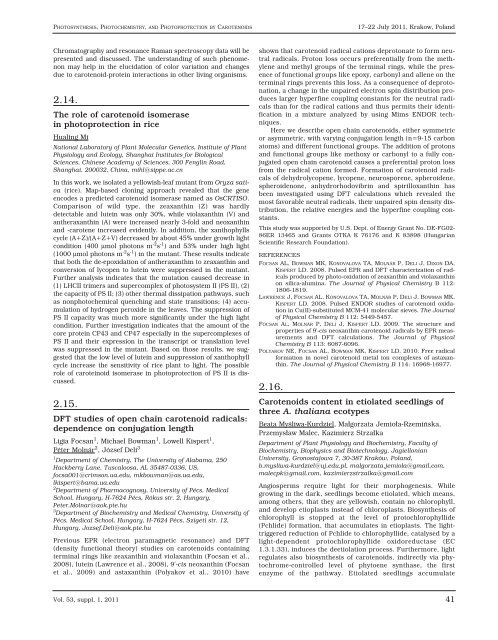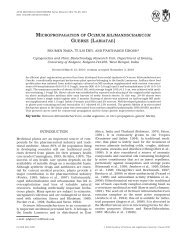ACTA BIOLOGICA CRACOVIENSIA
ACTA BIOLOGICA CRACOVIENSIA
ACTA BIOLOGICA CRACOVIENSIA
Create successful ePaper yourself
Turn your PDF publications into a flip-book with our unique Google optimized e-Paper software.
PHOTOSYNTHESIS, PHOTOCHEMISTRY, AND PHOTOPROTECTION BY CAROTENOIDS<br />
Chromatography and resonance Raman spectroscopy data will be<br />
presented and discussed. The understanding of such phenomenon<br />
may help in the elucidation of color variation and changes<br />
due to carotenoid-protein interactions in other living organisms.<br />
2.14.<br />
The role of carotenoid isomerase<br />
in photoprotection in rice<br />
Hualing Mi<br />
National Laboratory of Plant Molecular Genetics, Institute of Plant<br />
Physiology and Ecology, Shanghai Institutes for Biological<br />
Sciences, Chinese Academy of Sciences, 300 Fenglin Road,<br />
Shanghai, 200032, China, mihl@sippe.ac.cn<br />
In this work, we isolated a yellowish-leaf mutant from Oryza sativa<br />
(rice). Map-based cloning approach revealed that the gene<br />
encodes a predicted carotenoid isomerase named as OsCRTISO.<br />
Comparison of wild type, the zeaxanthin (Z) was hardly<br />
detectable and lutein was only 30%, while violaxanthin (V) and<br />
antheraxanthin (A) were increased nearly 3-fold and neoxanthin<br />
and -carotene increased evidently. In addition, the xanthophylls<br />
cycle (A+Z)/(A+Z+V) decreased by about 45% under growth light<br />
condition (400 μmol photons m -2 s -1 ) and 53% under high light<br />
(1000 μmol photons m -2 s -1 ) in the mutant. These results indicate<br />
that both the de-epoxidation of antheraxanthin to zeaxanthin and<br />
conversion of lycopen to lutein were suppressed in the mutant.<br />
Further analysis indicates that the mutation caused decrease in<br />
(1) LHCII trimers and supercomplex of photosystem II (PS II), (2)<br />
the capacity of PS II; (3) other thermal dissipation pathways, such<br />
as nonphotochemical quenching and state transitions; (4) accumulation<br />
of hydrogen peroxide in the leaves. The suppression of<br />
PS II capacity was much more significantly under the high light<br />
condition. Further investigation indicates that the amount of the<br />
core protein CP43 and CP47 especially in the supercomplexes of<br />
PS II and their expression in the transcript or translation level<br />
was suppressed in the mutant. Based on those results, we suggested<br />
that the low level of lutein and suppression of xanthophyll<br />
cycle increase the sensitivity of rice plant to light. The possible<br />
role of caroteinoid isomerase in photoprotection of PS II is discussed.<br />
2.15.<br />
DFT studies of open chain carotenoid radicals:<br />
dependence on conjugation length<br />
Ligia Focsan1 , Michael Bowman1 , Lowell Kispert1 ,<br />
Péter Molnár2 , József Deli3 1Department of Chemistry, The University of Alabama, 250<br />
Hackberry Lane, Tuscaloosa, AL 35487-0336, US,<br />
focsa001@crimson.ua.edu, mkbowman@as.ua.edu,<br />
lkispert@bama.ua.edu<br />
2Department of Pharmacognosy, University of Pécs, Medical<br />
School, Hungary, H-7624 Pécs, Rókus str. 2, Hungary,<br />
Peter.Molnar@aok.pte.hu<br />
3Department of Biochemistry and Medical Chemistry, University of<br />
Pécs, Medical School, Hungary, H-7624 Pécs, Szigeti str. 12,<br />
Hungary, Jozsef.Deli@aok.pte.hu<br />
Previous EPR (electron paramagnetic resonance) and DFT<br />
(density functional theory) studies on carotenoids containing<br />
terminal rings like zeaxanthin and violaxanthin (Focsan et al.,<br />
2008), lutein (Lawrence et al., 2008), 9'-cis neoxanthin (Focsan<br />
et al., 2009) and astaxanthin (Polyakov et al., 2010) have<br />
Vol. 53, suppl. 1, 2011<br />
shown that carotenoid radical cations deprotonate to form neutral<br />
radicals. Proton loss occurs preferentially from the methylene<br />
and methyl groups of the terminal rings, while the presence<br />
of functional groups like epoxy, carbonyl and allene on the<br />
terminal rings prevents this loss. As a consequence of deprotonation,<br />
a change in the unpaired electron spin distribution produces<br />
larger hyperfine coupling constants for the neutral radicals<br />
than for the radical cations and thus permits their identification<br />
in a mixture analyzed by using Mims ENDOR techniques.<br />
Here we describe open chain carotenoids, either symmetric<br />
or asymmetric, with varying conjugation length (n=9-15 carbon<br />
atoms) and different functional groups. The addition of protons<br />
and functional groups like methoxy or carbonyl to a fully conjugated<br />
open chain carotenoid causes a preferential proton loss<br />
from the radical cation formed. Formation of carotenoid radicals<br />
of dehydrolycopene, lycopene, neurosporene, spheroidene,<br />
spheroidenone, anhydrorhodovibrin and spirilloxanthin has<br />
been investigated using DFT calculations which revealed the<br />
most favorable neutral radicals, their unpaired spin density distribution,<br />
the relative energies and the hyperfine coupling constants.<br />
This study was supported by U.S. Dept. of Energy Grant No. DE-FG02-<br />
86ER 13465 and Grants OTKA K 76176 and K 83898 (Hungarian<br />
Scientific Research Foundation).<br />
REFERENCES<br />
FOCSAN AL, BOWMAN MK, KONOVALOVA TA, MOLNÁR P, DELI J, DIXON DA,<br />
KISPERT LD. 2008. Pulsed EPR and DFT characterization of radicals<br />
produced by photo-oxidation of zeaxanthin and violaxanthin<br />
on silica-alumina. The Journal of Physical Chemistry B 112:<br />
1806-1819.<br />
LAWRENCE J, FOCSAN AL, KONOVALOVA TA, MOLNÁR P, DELI J, BOWMAN MK,<br />
KISPERT LD. 2008. Pulsed ENDOR studies of carotenoid oxidation<br />
in Cu(II)-substituted MCM-41 molecular sieves. The Journal<br />
of Physical Chemistry B 112: 5449-5457.<br />
FOCSAN AL, MOLNÁR P, DELI J, KISPERT LD. 2009. The structure and<br />
properties of 9'-cis neoxanthin carotenoid radicals by EPR measurements<br />
and DFT calculations. The Journal of Physical<br />
Chemistry B 113: 6087-6096.<br />
POLYAKOV NE, FOCSAN AL, BOWMAN MK, KISPERT LD. 2010. Free radical<br />
formation in novel carotenoid metal ion complexes of astaxanthin.<br />
The Journal of Physical Chemistry B 114: 16968-16977.<br />
2.16.<br />
17–22 July 2011, Krakow, Poland<br />
Carotenoids content in etiolated seedlings of<br />
three A. thaliana ecotypes<br />
Beata Myśliwa-Kurdziel, Małgorzata Jemioła-Rzemińska,<br />
Przemysław Malec, Kazimierz Strzałka<br />
Department of Plant Physiology and Biochemistry, Faculty of<br />
Biochemistry, Biophysics and Biotechnology, Jagiellonian<br />
University, Gronostajowa 7, 30-387 Kraków, Poland,<br />
b.mysliwa-kurdziel@uj.edu.pl, malgorzata.jemiola@gmail.com,<br />
malecpk@gmail.com, kazimierzstrzalka@gmail.com<br />
Angiosperms require light for their morphogenesis. While<br />
growing in the dark, seedlings become etiolated, which means,<br />
among others, that they are yellowish, contain no chlorophyll,<br />
and develop etioplasts instead of chloroplasts. Biosynthesis of<br />
chlorophyll is stopped at the level of protochlorophyllide<br />
(Pchlide) formation, that accumulates in etioplasts. The lighttriggered<br />
reduction of Pchlide to chlorophyllide, catalysed by a<br />
light-dependent protochlorophyllide oxidoreductase (EC<br />
1.3.1.33), induces the deetiolation process. Furthermore, light<br />
regulates also biosynthesis of carotenoids, indirectly via phytochrome-controlled<br />
level of phytoene synthase, the first<br />
enzyme of the pathway. Etiolated seedlings accumulate<br />
41












